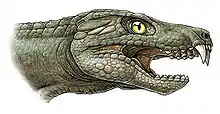Mariliasuchus
Mariliasuchus ("Marilia crocodile") is an extinct genus of Late Cretaceous notosuchian mesoeucrocodylian found near Marilia, Brazil. The first bone remains were found and collected in 1995 by Brazilian paleontologist William Nava, in red rocks from the fossiliferous Adamantina Formation.[1] Four years later, it was described as Mariliasuchus amarali, by Brazilian paleontologists Ismar de Souza Carvalho and Reinaldo J. Bertini.
| Mariliasuchus Temporal range: Late Cretaceous ~ | |
|---|---|
 | |
| Mariliasuchus amarali | |
| Scientific classification | |
| Domain: | Eukaryota |
| Kingdom: | Animalia |
| Phylum: | Chordata |
| Class: | Reptilia |
| Clade: | Pseudosuchia |
| Clade: | Crocodylomorpha |
| Suborder: | †Notosuchia |
| Family: | †Notosuchidae |
| Genus: | †Mariliasuchus Carvalho and Bertini, 1999 |
| Species | |
| |

Its type species M. amarali, in honour of Sérgio Estanislaw do Amaral, Brazilian naturalist. A second species, M. robustus, was named in 2007.[2]
Discovery
Several specimens of M. amarali have been found close to eggs, eggshells and coprolites to date: UFRJ DG 50-R (holotype): a partially complete and articulated skeleton, including a nearly complete skull and partially preserved axial and appendicular skeletons. It belongs to a juvenile specimen. UFRJ DG 105-R. UFRJ DG 106-R. MZSP-PV 50. MZSP-PV 51. MN 6298-V. MN 6756-V. URC R 67. URC R 68. URC R 69. MPM 114 Ic V - 4 eggs. MPM 115 R. MPM 116 R. MPM 117 R. MPM 119 R.
All of these specimens have been recovered in a road cut, 10 kilometres (6.2 mi) south from the city of Marilia, in outcrops known as "Estrada Velha" pto. 1 and 2. They come from the upper part of the Adamantina Formation, indicating a Late Cretaceous (possibly Campanian/Maastrichtian) age. The findings by William Nava could be found in the National Museum of Brazil, but they were partially destroyed in the 2018's National Museum of Brazil fire.[3]
Classification
A phylogenetic analysis done by Zaher et al. (2006) found Mariliasuchus amarali to share a close relationship with Comahuesuchus. Andrade et al. (2006), while studying the palate and choanae of some mesoeucrocodylians, reached this same conclusion. Though no name was given to this clade in either publication, it is referred in this article as Comahuesuchidae.
Palaeobiology

Mariliasuchus, unlike modern crocodylians, was an animal of terrestrial habits (though see below). Its nostrils were located on the front of the skull, unlike modern crocodiles, in which the nostrils face upwards, to help the animal breathe while its almost completely submerged. Furthermore, the eyes in M. amarali are faced laterally (in modern crocodiles they face upwards). It had a very modified dentition, differentiated in incisiforms, caniforms and molariforms. Strangelly, in particular, were the anterior-most teeth, which were directed horizontally rather than vertically. The function of this strange arrangement is not yet clear, but Vasconcellos et al. (2002) made comparisons with the dentition of pigs, indicating that their dietary preferences may be convergent. It also had strong jaw muscles, indicating a good degree of mandibular activity. There seems to be a significant degree of variation between specimens of M. amarali. Some of this is related to ontogenetic variation, but some may also suggest sexual dimorphism, or even that some of the specimens assigned to this species belong to a different animal.
Ontogenetic studies done by Vasconcellos and Carvalho (2005) concluded that during its growth, the skull of M. amarali individuals becomes shorter and the skull more resistant, while being laterally compressed. In adulthood, the orbit has a less circular arrangement than in younger individuals.
The postcranial skeleton of Mariliasuchus amarali displays a mixture of traits similar to those present in the skeleton of Cretaceous terrestrial crocodyliform Notosuchus and traits present in aquatic eusuchian crocodyliform, including living crocodilians. Nobre and Carvalho (2013) inferred that Mariliasuchus did not have an erect or semi-erect posture, but rather a sprawling posture and, possibly, had amphibian habits similar to those of living crocodilians.[4]
References
- Mariliasuchus at Fossilworks.org
- Pedro Henrique Nobre; Ismar de Souza Carvalho; Felipe Mesquita de Vasconcellos & Willian Roberto Nava (2007). "Mariliasuchus robustus, a new Crocodylomorpha (Mesoeucrocodylia) from the Bauru Basin, Brazil". Anuário do Instituto de Geociências. 30 (1): 38–49. doi:10.11137/2007_1_38-49. ISSN 0101-9759.pdf
- "Parte do acervo paleontológico de Marília é perdida no incêndio do Museu Nacional". G1. Retrieved 24 September 2022.
- Pedro Henrique Nobre & Ismar de Souza Carvalho (2013). "Postcranial skeleton of Mariliasuchus amarali Carvalho and Bertini, 1999 (Mesoeucrocodylia) from the Bauru Basin, Upper Cretaceous of Brazil". Ameghiniana. 50 (1): 98–113. doi:10.5710/amgh.15.8.2012.500. S2CID 56306777.
Further reading
- Andrade, M.B.; Bertini, R.J.; Pinheiro, A.E.P. (2006). "Observations on the palate and choanae structures in Mesoeucrocodylia (Archosauria, Crocodylomorpha): phylogenetic implications" (PDF). Revista Brasileira de Paleontologia. 9 (3): 323–332. doi:10.4072/rbp.2006.3.07.
- Vasconcellos, F.M.; Carvalho, I.S. (2006). "Inferências morfofuncionais e ontogenéticas sobre o crânio de Mariliasuchus amarali Carvalho & Bertini 1999, Crocodylomorpha cretácico da Formação Araçatuba/Adamantina, Bacia Bauru, Brasil" (PDF). Paleontologia de Vertebrados: Grandes Temas e Contribuições Científicas: 229–239. Archived from the original (PDF) on 2007-09-28.
- Vasconcellos, F.M.; Carvalho, I.S.; Nobre, P.H. (2002). "Aspectos ecológicos de Mariliasuchus amarali (Crocodylomorpha) do" (PDF). Cretáceo Superior da Bacia Bauru. Paleontologia em Destaque. 40: 43–44. Archived from the original (PDF) on 2007-09-28.
- Zaher, H.; Pol, D.; Carvalho, A.B.; Riccomini, C.; Campos, D.; Nava, W. (2006). "Re-description of the cranial morphology of Mariliasuchus amarali, and its phylogenetic affinities (Crocodyliformes, Notosuchia)" (PDF). American Museum Novitates (3512): 1–40. doi:10.1206/0003-0082(2006)3512[1:ROTCMO]2.0.CO;2. ISSN 0003-0082. S2CID 73552420.
